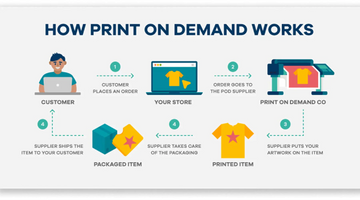People who seek to understand more about e-commerce will find a lot of chances in the digital world. Dropshipping and Print on Demand (POD) are two new business models that are changing the way people shop online. Before we talk about why you should use them in your 2024 strategy, it's important to understand what each model is all about and how it works with the others, and how it's different.
What is Print on Demand (POD)?
Print on Demand is a procedure in which you collaborate with a supplier to personalize white-label products (such as t-shirts, shoes, or books) with your designs and sell them on a per-order basis under your own brand. Similar to dropshipping, you do not pay for the product until you sell it, so there is no need to buy in bulk or keep inventory.
What is Dropshipping?
Dropshipping is a way for stores to complete orders when they don't keep the items they sell in stock. You buy the item from a third party and have it shipped straight to the customer when you sell something. So, you never get to see or touch the product. This plan makes starting an e-commerce business much easier and less risky because it gets rid of the need to manage inventory and pay for it all up front.
Relationship and Differences
While both dropshipping and POD use a fulfillment approach that does not require inventory, they target different e-commerce niches. Dropshipping enables you to offer a diverse range of products without the inconvenience of production or shipping. In contrast, POD emphasizes customisation, providing your consumers with one-of-a-kind products that are tailored to their preferences. The main distinction is in the product offering: dropshipping can include any goods, whereas POD is exclusively for bespoke things. Together, they offer a comprehensive e-commerce strategy that combines the broad appeal of diverse product lines with the distinct selling point of personalized items.
Now, let's take a look at eight key reasons why incorporating dropshipping and POD into your e-commerce strategy will set you up for success in 2024.
1. Minimized Risk and Investment
Starting an e-commerce business typically involves a lot of risk, especially in terms of inventory management and initial costs. Dropshipping and POD avoid these issues by removing the requirement for physical inventory. This strategy not only eliminates the risk of unsold inventory, but it also lowers the entry barrier for new entrepreneurs, making it an excellent starting point for creating an online business.
2. Streamlined Operations
Dropshipping and point-of-sale (POD) both make it easier to run an e-commerce business. By hiring outside companies to handle your inventory, production, and shipping, you can focus on things like marketing, customer interaction, and brand development that will help your business grow.
3. Unlimited Product Range
Combining dropshipping with POD allows you to diversify your product offerings significantly. While dropshipping offers access to a wide range of products across various categories, POD enables you to tap into the market for customized and personalized items. This dual approach ensures that your store can quickly adapt to changing market trends and consumer preferences.
4. Customization and Branding Opportunities
POD services provide unparalleled customization, enabling businesses to develop distinctive, branded items that stand out in the congested online marketplace. The ability to personalize goods, from garments to accessories, may greatly increase your brand's attractiveness and establish a stronger connection with your customers. When combined with dropshipping's efficiency, this method allows you to offer a diverse, appealing product line that actually resonates with your target audience.
5. Scalability
As your e-commerce store grows, the combined dropshipping and POD model scales with you. This duo is perfectly suited to handle fluctuations in demand, with no need for physical inventory adjustments. Whether you're receiving ten orders a day or a thousand, your business can adapt seamlessly, ensuring that your growth trajectory remains unhindered by logistical constraints.
6. Global Reach
With dropshipping and POD, geographical boundaries become less of a concern. These models allow you to sell and ship products worldwide without the logistical nightmares of international warehousing and shipping. This global reach opens up vast new markets and customer bases, providing a significant growth opportunity for your e-commerce business.
7. Easy Market Entry and Testing
The combination of dropshipping and POD lowers the barrier to entry for new e-commerce ventures, making it easier than ever to launch and scale an online store. Moreover, this approach allows for rapid market testing of products and designs without substantial upfront investment. You can gauge customer interest and react to trends in real-time, refining your offerings to better meet market demand.
8. Enhanced Customer Experience
Consumers today place a high importance on product variety and personalisation. You can adapt to varied client demands and tastes by using dropshipping for a wide range of products and POD for custom offerings. This intentional diversity improves the consumer experience, resulting in increased happiness, repeat business, and positive word-of-mouth—all critical components of online retail success.
As we approach 2024, the collaboration between dropshipping and Print on Demand emerges as a transformative strategy for e-commerce enterprises. This strong combination provides a low-risk, flexible, and scalable approach to online shopping, as well as the tools required to establish a successful, customer-focused business. Whether you're just getting started or want to diversify your existing online business, adopting the dropshipping and POD combination could be the key to realising your e-commerce potential in the ever-changing digital marketplace.












